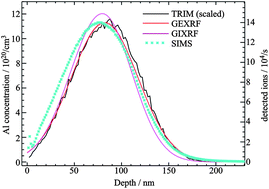Characterization of ultra-shallow aluminum implants in silicon by grazing incidence and grazing emission X-ray fluorescence spectroscopy
Abstract
In this work two synchrotron radiation-based depth-sensitive X-ray fluorescence techniques, grazing incidence X-ray fluorescence (GIXRF) and grazing emission X-ray fluorescence (GEXRF), are compared and their potential for non-destructive depth-profiling applications is investigated. The depth-profiling capabilities of the two methods are illustrated for five aluminum-implanted silicon wafers all having the same implantation dose of 1016 atoms per cm2 but with different implantation energies ranging from 1 keV up to 50 keV. The work was motivated by the ongoing downscaling effort of the microelectronics industry and the resulting need for more sensitive methods for the impurity and dopant depth-profile control. The principles of GIXRF and GEXRF, both based on the refraction of X-rays at the sample surface to enhance the surface-to-bulk ratio of the detected fluorescence signal, are explained. The complementary experimental setups employed at the Physikalisch-Technische Bundesanstalt (PTB) for GIXRF and the University of Fribourg for GEXRF are presented in detail. In particular, for each technique it is shown how the dopant depth profile can be derived from the angular intensity dependence of the Al Kα fluorescence line. The results are compared to theoretical predictions and, for two samples, crosschecked with values obtained from


 Please wait while we load your content...
Please wait while we load your content...